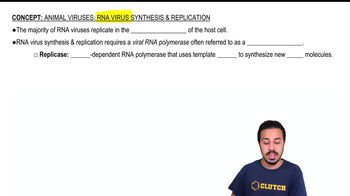A virus with RNA-dependent RNA polymerase
a. synthesizes DNA from an RNA template.
b. synthesizes double-stranded RNA from an RNA template.
c. synthesizes double-stranded RNA from a DNA template.
d. transcribes mRNA from DNA.
e. none of the above
 Verified step by step guidance
Verified step by step guidance



A virus with RNA-dependent RNA polymerase
a. synthesizes DNA from an RNA template.
b. synthesizes double-stranded RNA from an RNA template.
c. synthesizes double-stranded RNA from a DNA template.
d. transcribes mRNA from DNA.
e. none of the above
Label the principal events of attachment, biosynthesis, entry, and maturation of a + stranded RNA virus. Draw in uncoating. <IMAGE>
Which of the following would be the first step in the biosynthesis of a virus with reverse transcriptase?
a. A complementary strand of RNA must be synthesized.
b. Double-stranded RNA must be synthesized.
c. A complementary strand of DNA must be synthesized from an RNA template.
d. A complementary strand of DNA must be synthesized from a DNA template.
e. none of the above
An example of lysogeny in animals could be
a. slow viral infections.
b. latent viral infections.
c. T-even bacteriophages.
d. infections resulting in cell death.
e. none of the above
Some antibiotics activate phage genes. MRSA releasing Panton-Valentine leukocidin is a toxin that can cause a life-threatening disease. Why can such a disease develop following antibiotic treatment?
The ability of a virus to infect an organism is regulated by
a. the host species.
b. the type of cells.
c. the availability of an attachment site.
d. cell factors necessary for viral replication.
e. all of the above